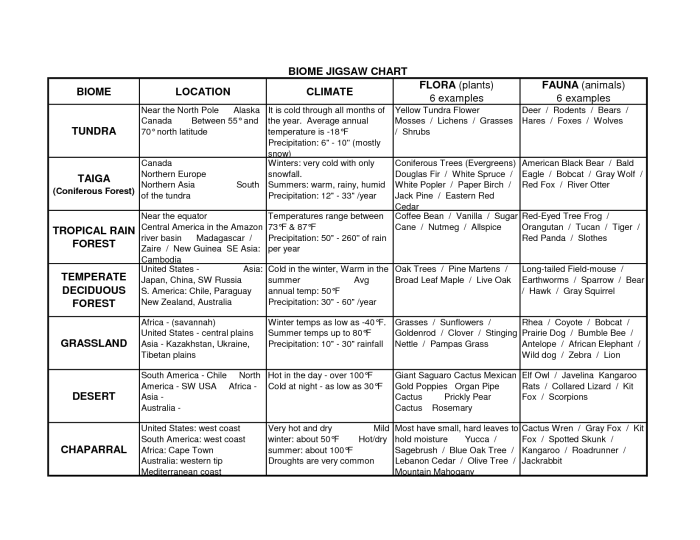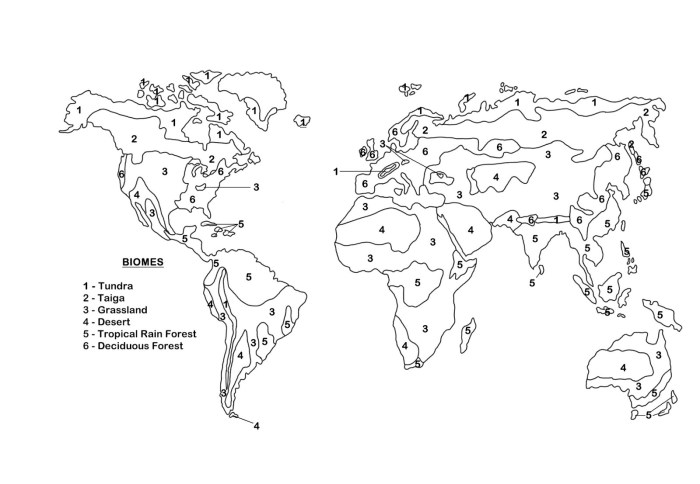Embark on a captivating exploration with the Color the North American Biomes Worksheet Answer Key, a treasure trove of knowledge that unlocks the secrets of our continent’s diverse ecosystems. This comprehensive guide unveils the intricate tapestry of biomes, each a unique realm shaped by climate, vegetation, and animal life.
Delve into the fascinating world of biogeography as we unravel the key characteristics of each biome, from the towering forests of the Pacific Northwest to the sun-kissed deserts of the Southwest. Discover the interplay between living organisms and their environment, gaining a deeper appreciation for the delicate balance that sustains our planet.
Biomes of North America

Biomes are large-scale ecosystems that share similar climate, vegetation, and animal life. They are determined by factors such as temperature, precipitation, and soil type. North America is home to a wide variety of biomes, including forests, grasslands, deserts, and tundra.
Key Characteristics of North American Biomes, Color the north american biomes worksheet answer key
- Forestsare characterized by dense vegetation, with trees as the dominant plant form. They receive moderate to high precipitation and have a relatively mild climate.
- Grasslandsare characterized by open, grassy plains. They receive moderate precipitation and have a temperate climate.
- Desertsare characterized by sparse vegetation and a lack of water. They receive very little precipitation and have a hot, dry climate.
- Tundrais characterized by a cold, dry climate and a lack of trees. It is found in the Arctic and subarctic regions of North America.
Color-Coding Biomes

Color-coding biomes is a useful way to visualize their distribution on a map or worksheet. Each biome is assigned a specific color, making it easy to see where different biomes are located.
Legend
- Green:Forests
- Yellow:Grasslands
- Orange:Deserts
- White:Tundra
Advantages of Color Coding
- Makes it easy to see where different biomes are located
- Helps students understand biome distribution
- Can be used to create maps and other visual aids
Disadvantages of Color Coding
- Can be difficult to distinguish between similar colors
- May not be accurate for all biomes
Worksheet Answer Key
| Question | Answer |
|---|---|
| What biome is characterized by dense vegetation and trees? | Forests |
| What biome is characterized by open, grassy plains? | Grasslands |
| What biome is characterized by sparse vegetation and a lack of water? | Deserts |
| What biome is characterized by a cold, dry climate and a lack of trees? | Tundra |
Educational Value: Color The North American Biomes Worksheet Answer Key

A color-coded biome worksheet can be a valuable educational tool. It can help students understand biome distribution and ecosystem dynamics. The worksheet can be used in a variety of ways, such as:
- As a pre-assessment to gauge students’ prior knowledge of biomes
- As a review activity after a lesson on biomes
- As a homework assignment to reinforce learning
- As a basis for class discussion or debate
FAQ Section
What is the purpose of color-coding biomes on a worksheet?
Color-coding biomes enhances visual representation, allowing for quick identification and comparison of different biomes based on their geographical distribution.
How can the Color the North American Biomes Worksheet Answer Key be used in the classroom?
This worksheet can be incorporated into lessons on biogeography, ecology, and environmental science, providing students with a hands-on tool for understanding biome distribution and ecosystem dynamics.
What are the educational benefits of using a color-coded biome worksheet?
Color-coded biome worksheets promote spatial reasoning, improve visual literacy, and facilitate the comprehension of complex ecological concepts.